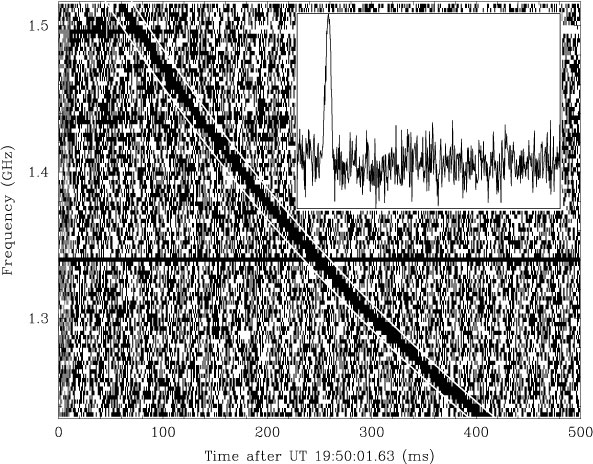 |
| From Lorimer et al. (2007). |
The first FRB detection was published in Lorimer et al. (2007). Using data from the Parkes radio telescope, they detected an extremely bright, non-repeating, millisecond duration radio burst. At radio frequencies, pulsed emission is dispersed by intervening diffuse cold plasma, meaning low-frequency emission arrives at Earth after high-frequency emission. Measurements of the amount of dispersion allow for inferences regarding the total electron content between the emission and observation locations. With FRBs, the dispersion is so great that it cannot be explained by the electron content of the Milky Way alone. It is possible that much of the dispersion is due to propagation through vast swaths of the very diffuse intergalactic medium and that the sources of FRBs are at cosmological distances. If that is the case, their brightness hints at truly extraordinary energetics and a very exciting new type of astrophysical transient.
Several more of these FRBs were detected by Thornton et al. (2013), all with Parkes. With very small number statistics, it began to appear that FRBs were not tracking the stellar density of the Milky Way and were instead distributed seemingly isotropically, consistent with a cosmological source population. It was worrisome that all of these were being detected with Parkes. Parkes might have just had this serendipitous combination of field-of-view and sensitivity to make it great for detecting these things, or maybe there was some devious source of radio frequency interference influencing the observatory. And indeed, Petroff et al. (2015) realized that a microwave at Parkes, when opened prematurely, caused so-called "perytons" which almost perfectly mimicked the dispersive sweep of an astrophysical radio burst. However, not all FRBs were perytons. Many of them appeared to be bonafide astrophysical events. FRB detections at Arecibo and The Green Bank Telescope helped to allay microwave fears and build the case for these things being astrophysical in nature.
Now, back to Molonglo. The Molonglo telescope is over 50 years old. It has a giant cylindrical collecting area with hundreds of dipole antennas. Over the last several years, it has been subjected to a massive overhaul of its digital systems and is now capable of processing vast quantities of high time resolution radio data. It can synthesize many beams and survey large areas of the sky at once. It is a fantastic example of a relatively new trend in radio instrumentation: digital processing and software developments are driving much of the new science at low radio frequencies (below 2 GHz). Similar examples are the remarkable European LOFAR telescope and the soon-to-be complete Canadian CHIME telescope. This recent paper describes new and improved digital data processing capabilities at Arecibo for FRB searches. Note that Arecibo's funding situation is currently very precarious even as the case for its science capabilities is growing.
In the Molonglo article, Matthew Bailes from Swinburne University of Technology describes how there are currently more theories for what causes FRBs than there are observed FRBs. This is certainly the case. There are only about 15 published FRBs and theories for what may cause them range from flare stars to supergiant pulses from pulsars to merging neutron stars to core collapse supernovae and more. I'd say you should expect this to change within about 18 months. New and existing but improved instruments are going to start finding these things by the dozen. We're on the verge of learning a lot about FRBs.
No comments:
Post a Comment